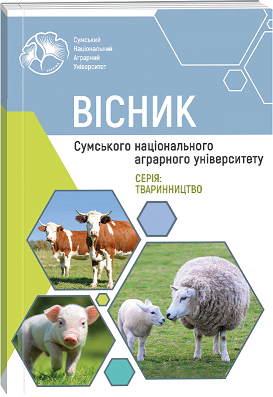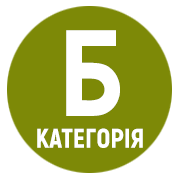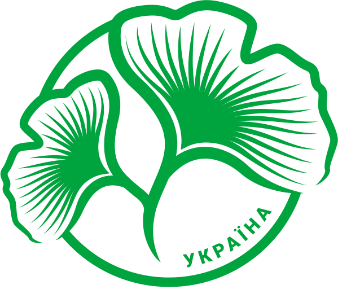ДЖЕРЕЛА ПРОТЕЇНУ У ГОДІВЛІ СВИНЕЙ
Анотація
Метою цього дослідження було визначення найбільш ефективних джерел протеїну для годівлі свиней, враховуючи поживну цінність, засвоюваність амінокислот, вміст антипоживних речовин, економічну доцільність і виробничі потреби. Це дослідження аналізує сучасні підходи до вибору та застосування рослинних і тваринних джерел білка у годівлі свиней. Особливу увагу приділено критеріям оцінки джерел протеїну, включаючи поживну цінність, доступність, екологічну стійкість, економічну доцільність і потенційні ризики використання антипоживних речовин. Серед рослинних джерел найвищу цінність демонструє соєвий шрот завдяки оптимальному амінокислотному профілю та високій засвоюваності, яка може досягати 90%. Однак важливим аспектом є його попередня обробка для зниження рівня інгібіторів трипсину. Інші рослинні компоненти, такі як ріпаковий і соняшниковий шроти, мають свої переваги, але їх використання обмежується високим вмістом клітковини і нижчим рівнем ключових амінокислот, таких як лізин. Бавовняний шрот характеризується токсичністю через наявність госиполу, тоді як горох польовий пропонує низький вміст антипоживних речовин і значну енергетичну цінність. У сфері тваринних джерел білка виділяються продукти крові, рибне та м'ясо-кісткове борошно. Продукти крові забезпечують високий вміст лізину і амінокислот, які легко засвоюються, але потребують ретельної обробки для зниження ризиків забруднення. Рибне борошно містить омега-3 жирні кислоти, що сприятливо впливають на споживання корму, хоча його застосування ускладнене через високу вартість і мінливість якості. М'ясо-кісткове борошно надає необхідні мінерали, але характеризується нижчою засвоюваністю амінокислот через технологічні обмеження. Загалом, ефективне управління раціонами вимагає комплексного підходу до використання джерел протеїну, враховуючи їх властивості, можливості обробки та специфіку годівлі свиней. Збалансоване поєднання рослинних і тваринних джерел протеїну дозволяє підвищити продуктивність, оптимізувати витрати та мінімізувати екологічний вплив виробництва.
Посилання
2. Almeida, F. N., Htoo, J. K., Thomson, J., & Stein, H. H. (2013). Comparative amino acid digestibility in US blood products fed to weanling pigs. Animal Feed Science and Technology, 181(1-4), 80–86. https://doi.org/10.1016/j.anifeedsci.2013.03.002
3. Almeida, F. N., Sulabo, R. C., & Stein, H. H. (2014). Amino acid digestibility and concentration of digestible and metabolizable energy in a threonine biomass product fed to weanling pigs. Journal of Animal Science, 92(10), 4540–4546. https://doi.org/10.2527/jas.2013-6635
4. Altmann, B. A., Neumann, C., Rothstein, S., Liebert, F., & Mörlein, D. (2019). Do dietary soy alternatives lead to pork quality improvements or drawbacks? A look into micro-alga and insect protein in swine diets. Meat Science, 153 26–34. https://doi.org/10.1016/j.meatsci.2019.03.001
5. Angell, A. R., Angell, S. F., de Nys, R., & Paul, N. A. (2016). Seaweed as a protein source for mono-gastric livestock. Trends in Food Science & Technology, 54, 74–84. https://doi.org/10.1016/j.tifs.2016.05.014
6. Avilés-Gaxiola, S., Chuck-Hernández, C., & Serna Saldívar, S. O. (2017). Inactivation methods of trypsin inhibitor in legumes: A review. Journal of Food Science, 83(1), 17–29. https://doi.org/10.1111/1750-3841.13985
7. Barragan-Fonseca, K. B., Dicke, M., & van Loon, J. J. A. (2017). Nutritional value of the black soldier fly (Hermetia illucens L.) and its suitability as animal feed – a review. Journal of Insects as Food and Feed, 3(2), 105–120. https://doi.org/10.3920/jiff2016.0055
8. Biasato, I., Renna, M., Gai, F., Dabbou, S., Meneguz, M., Perona, G., Martinez, S., Lajusticia, A. C. B., Bergagna, S., Sardi, L., Capucchio, M. T., Bressan, E., Dama, A., Schiavone, A., & Gasco, L. (2019). Partially defatted black soldier fly larva meal inclusion in piglet diets: Effects on the growth performance, nutrient digestibility, blood profile, gut morphology and histological features. Journal of Animal Science and Biotechnology, 10(1). https://doi.org/10.1186/s40104-019-0325-x
9. Cervantes-Pahm, S. K., & Stein, H. H. (2010). Ileal digestibility of amino acids in conventional, fermented, and enzyme-treated soybean meal and in soy protein isolate, fish meal, and casein fed to weanling pigs1. Journal of Animal Science, 88(8), 2674–2683. https://doi.org/10.2527/jas.2009-2677
10. Chia, Tanga, Osuga, Alaru, Mwangi, Githinji, Subramanian, Fiaboe, Ekesi, van Loon & Dicke. (2019). Effect of dietary replacement of fishmeal by insect meal on growth performance, blood profiles and economics of growing pigs in kenya. Animals, 9(10), 705. https://doi.org/10.3390/ani9100705
11. Corino, C., Modina, S. C., Di Giancamillo, A., Chiapparini, S., & Rossi, R. (2019a). Seaweeds in pig nutrition. Animals, 9(12), 1126. https://doi.org/10.3390/ani9121126
12. da Rosa, D. P., Vieira, M. d. M., Kessler, A. M., de Moura, T. M., Frazzon, A. P. G., McManus, C. M., Marx, F. R., Melchior, R., & Ribeiro, A. M. L. (2015). Efficacy of hyperimmunized hen egg yolks in the control of diarrhea in newly weaned piglets. Food and Agricultural Immunology, 26(5), 622–634. https://doi.org/10.1080/09540105.2014.998639
13. Degola, L., & Jonkus, D. (2018). The influence of dietary inclusion of peas, faba bean and lupin as a replacement for soybean meal on pig performance and carcass traits.
14. Engle, M. J. (1994). The role of soybean meal hypersensitivity in postweaning lag and diarrhea in piglets. Journal of Swine Health and Production. 2:7-10.
15. Gadelha, I. C. N., Fonseca, N. B. S., Oloris, S. C. S., Melo, M. M., & Soto-Blanco, B. (2014). Gossypol toxicity from cottonseed products. The Scientific World Journal, 2014, 1–11. https://doi.org/10.1155/2014/231635
16. García-Vaquero, M., Brunton, N., & Lafarga, T. (2021). Microalgae as a source of pigments for food applications. У Cultured microalgae for the food industry (с. 177–198). Elsevier. https://doi.org/10.1016/b978-0-12-821080-2.00014-9
17. Gasco, L., Finke, M., & van Huis, A. (2018). Can diets containing insects promote animal health? Journal of Insects as Food and Feed, 4(1), 1–4. https://doi.org/10.3920/jiff2018.x001
18. Gonzalez-Vega, J. C., & Stein, H. H. (2012). Amino acid digestibility in canola, cottonseed, and sunflower products fed to finishing pigs. Journal of Animal Science, 90(12), 4391–4400. https://doi.org/10.2527/jas.2011-4631
19. Goodband, B., Tokach, M., Dritz, S., DeRouchey, J., & Woodworth, J. (2014). Practical starter pig amino acid requirements in relation to immunity, gut health and growth performance. Journal of Animal Science and Biotechnology, 5(1). https://doi.org/10.1186/2049-1891-5-12
20. Grinstead, G. S., Goodband, R. D., Nelssen, J. L., Tokach, M. D., & Dritz, S. S. (2000). A review of whey processing, products and components: Effects on weanling pig performance. Journal of Applied Animal Research, 17(1), 133–150. https://doi.org/10.1080/09712119.2000.9706296
21. Hejdysz, M., Kaczmarek, S. A., & Rutkowski, A. (2016). Extrusion cooking improves the metabolisable energy of faba beans and the amino acid digestibility in broilers. Animal Feed Science and Technology, 212, 100–111. https://doi.org/10.1016/j.anifeedsci.2015.12.008
22. Jones, A. M., Wu, F., Woodworth, J. C., Tokach, M. D., Goodband, R. D., DeRouchey, J. M., & Dritz, S. S. (2018). Evaluating the effects of fish meal source and level on growth performance of nursery pigs1,2. Translational Animal Science, 2(2), 144–155. https://doi.org/10.1093/tas/txy010
23. Jones, C. K., DeRouchey, J. M., Nelssen, J. L., Tokach, M. D., Dritz, S. S., & Goodband, R. D. (2010). Effects of fermented soybean meal and specialty animal protein sources on nursery pig performance1,2. Journal of Animal Science, 88(5), 1725–1732. https://doi.org/10.2527/jas.2009-2110
24. Keegan, T. P., DeRouchey, J. M., Nelssen, J. L., Tokach, M. D., Goodband, R. D., & Dritz, S. S. (2004). The effects of poultry meal source and ash level on nursery pig performance1. Journal of Animal Science, 82(9), 2750–2756. https://doi.org/10.2527/2004.8292750x
25. Kerr, B. J., Kidd, M. T., Cuaron, J. A., Bryant, K. L., Parr, T. M., Maxwell, C. V., & Weaver, E. (2004). Utilization of spray-dried blood cells and crystalline isoleucine in nursery pig diets1. Journal of Animal Science, 82(8), 2397–2404. https://doi.org/10.2527/2004.8282397x
26. Kibria, S., & Kim, I. H. (2019). Impacts of dietary microalgae (Schizochytrium JB5) on growth performance, blood profiles, apparent total tract digestibility, and ileal nutrient digestibility in weaning pigs. Journal of the Science of Food and Agriculture, 99(13), 6084–6088. https://doi.org/10.1002/jsfa.9886
27. Kim, S. W. (2010). Bio-fermentation technology to improve efficiency of swine nutrition. Asian-Australasian journal of animal sciences, 23(6), 825-832.
28. Kim, S. W., & Easter, R. A. (2001). Nutritional value of fish meals in the diet for young pigs. Journal of Animal Science, 79(7), 1829. https://doi.org/10.2527/2001.7971829x
29. Kong, C., Kang, H. G., Kim, B. G., & Kim, K. H. (2014). Ileal digestibility of amino acids in meat meal and soybean meal fed to growing pigs. Asian-Australasian Journal of Animal Sciences, 27(7), 990–995. https://doi.org/10.5713/ajas.2014.14217
30. Kumar, N., Bansal, A., Sarma, G. S., & Rawal, R. K. (2014). Chemometrics tools used in analytical chemistry: An overview. Talanta, 123, 186–199. https://doi.org/10.1016/j.talanta.2014.02.003
31. Li, D. F., Nelssen, J. L., Reddy, P. G., Blecha, F., Hancock, J. D., Allee, G. L., Goodband, R. D., & Klemm, R. D. (1990). Transient hypersensitivity to soybean meal in the early-weaned pig. Journal of Animal Science, 68(6), 1790. https://doi.org/10.2527/1990.6861790x
32. Liu, Y., Song, M., Maison, T., & Stein, H. H. (2014). Effects of protein concentration and heat treatment on concentration of digestible and metabolizable energy and on amino acid digestibility in four sources of canola meal fed to growing pigs. Journal of Animal Science, 92(10), 4466–4477. https://doi.org/10.2527/jas.2013-7433
33. Llames, C. R., & Fontaine, J. (1994). Determination of amino acids in feeds: Collaborative study. Journal of AOAC INTERNATIONAL, 77(6), 1362–1402. https://doi.org/10.1093/jaoac/77.6.1362
34. Lombardi, G. V., Parrini, S., Atzori, R., Stefani, G., Romano, D., Gastaldi, M., & Liu, G. (2021). Sustainable agriculture, food security and diet diversity. The case study of Tuscany, Italy. Ecological Modelling, 458, 109702.
35. Makkar, H. P. S., Tran, G., Heuzé, V., Giger-Reverdin, S., Lessire, M., Lebas, F., & Ankers, P. (2016). Seaweeds for livestock diets: A review. Animal Feed Science and Technology, 212, 1–17. https://doi.org/10.1016/j.anifeedsci. 2015.09.018
36. Mejicanos, G., Sanjayan, N., Kim, I. H., & Nyachoti, C. M. (2016). Recent advances in canola meal utilization in swine nutrition. Journal of Animal Science and Technology, 58(1). https://doi.org/10.1186/s40781-016-0085-5
37. Meng, Z., Liu, Q., Zhang, Y., Chen, J., Sun, Z., Ren, C., Zhang, Z., Cheng, X., & Huang, Y. (2021). Nutritive value of faba bean ( Vicia faba L.) as a feedstuff resource in livestock nutrition: A review. Food Science & Nutrition, 9(9), 5244–5262. https://doi.org/10.1002/fsn3.2342
38. Milczarek, A., & Osek, M. (2016). 13. partial replacement of soybean with low-tannin faba bean varieties (albus or amulet): Effects on growth traits, slaughtering parameters and meat quality of puławska pigs. Annals of Animal Science, 16(2), 477–487. https://doi.org/10.1515/aoas-2015-0076
39. Morris, G. K., W. T. Martin, W. H. Shelton, J. G. Wells, and P. S. Brachman. (1970). Salmonellae in fish meal plants: Relative amounts of contamination at various stages of processing and a method of control. Applied Microbiology. 19:401-408
40. Multari, S., Stewart, D., & Russell, W. R. (2015). Potential of fava bean as future protein supply to partially replace meat intake in the human diet. Comprehensive Reviews in Food Science and Food Safety, 14(5), 511–522. https://doi.org/10.1111/1541-4337.12146
41. Mungkung, R., Aubin, J., Prihadi, T. H., Slembrouck, J., van der Werf, H. M. G., & Legendre, M. (2013). Life Cycle Assessment for environmentally sustainable aquaculture management: A case study of combined aquaculture systems for carp and tilapia. Journal of Cleaner Production, 57, 249–256. https://doi.org/10.1016/j.jclepro.2013.05.029
42. Myers, A. J., Goodband, R. D., Tokach, M. D., Dritz, S. S., DeRouchey, J. M., & Nelssen, J. L. (2014). The effects of porcine intestinal mucosa protein sources on nursery pig growth performance1. Journal of Animal Science, 92(2), 783–792. https://doi.org/10.2527/jas.2013-6551
43. Nijdam, D., Rood, T., & Westhoek, H. (2012). The price of protein: Review of land use and carbon footprints from life cycle assessments of animal food products and their substitutes. Food Policy, 37(6), 760–770. https://doi.org/10.1016/j.foodpol.2012.08.002
44. Nutrient requirements of swine. (2012). National Academies Press. https://doi.org/10.17226/13298
45. Øverland, M., Mydland, L. T., & Skrede, A. (2018). Marine macroalgae as sources of protein and bioactive compounds in feed for monogastric animals. Journal of the Science of Food and Agriculture, 99(1), 13–24. https://doi.org/10.1002/jsfa.9143
46. Parisi, G., Tulli, F., Fortina, R., Marino, R., Bani, P., Dalle Zotte, A., De Angelis, A., Piccolo, G., Pinotti, L., Schiavone, A., Terova, G., Prandini, A., Gasco, L., Roncarati, A., & Danieli, P. P. (2020). Protein hunger of the feed sector: The alternatives offered by the plant world. Italian Journal of Animal Science, 19(1), 1204–1225. https://doi.org/10.1080/1828051x.2020.1827993
47. Parr, C. K., Liu, Y., Parsons, C. M., & Stein, H. H. (2015). Effects of high-protein or conventional canola meal on growth performance, organ weights, bone ash, and blood characteristics of weanling pigs. Journal of Animal Science, 93(5), 2165–2173. https://doi.org/10.2527/jas.2014-8439
48. Parrini, S., Aquilani, C., Pugliese, C., Bozzi, R., & Sirtori, F. (2023). Soybean replacement by alternative protein sources in pig nutrition and its effect on meat quality. Animals, 13(3), 494. https://doi.org/10.3390/ani13030494
49. Pieper, R., Taciak, M., Pieper, L., Święch, E., Tuśnio, A., Barszcz, M., Vahjen, W., Skomiał, J., & Zentek, J. (2016). Comparison of the nutritional value of diets containing differentially processed blue sweet lupin seeds or soybean meal for growing pigs. Animal Feed Science and Technology, 221, 79–86. https://doi.org/10.1016/j.anifeedsci.2016.08.026
50. Reckmann, K., Blank, R., Traulsen, I., & Krieter, J. (2016). Comparative life cycle assessment (LCA) of pork using different protein sources in pig feed. Archives Animal Breeding, 59(1), 27–36. https://doi.org/10.5194/aab-59-27-2016
51. Remus, A., Andretta, I., Kipper, M., Lehnen, C. R., Klein, C. C., Lovatto, P. A., & Hauschild, L. (2013). A metaanalytical study about the relation of blood plasma addition in diets for piglets in the post-weaning and productive performance variables. Livestock Science, 155(2-3), 294–300. https://doi.org/10.1016/j.livsci.2013.04.020
52. Sanjayan, N., Heo, J. M., & Nyachoti, C. M. (2014). Nutrient digestibility and growth performance of pigs fed diets with different levels of canola meal from Brassica napus black and Brassica juncea yellow1. Journal of Animal Science, 92(9), 3895–3905. https://doi.org/10.2527/jas.2013-7215
53. Skylas, D. J., Paull, J. G., Hughes, D. G. D., Gogel, B., Long, H., Williams, B., Mundree, S., Blanchard, C. L., & Quail, K. J. (2019). Nutritional and anti-nutritional seed-quality traits of faba bean (Vicia faba) grown in South Australia. Crop and Pasture Science, 70(5), 463. https://doi.org/10.1071/cp19017
54. Smith, L. A., Houdijk, J. G. M., Homer, D., & Kyriazakis, I. (2013). Effects of dietary inclusion of pea and faba bean as a replacement for soybean meal on grower and finisher pig performance and carcass quality1. Journal of Animal Science, 91(8), 3733–3741. https://doi.org/10.2527/jas.2012-6157
55. Song, M., Che, T. M., Liu, Y., Soares, J. A., Harmon, B. G., & Pettigrew, J. E. (2012). Effects of dietary spraydried egg on growth performance and health of weaned pigs1. Journal of Animal Science, 90(9), 3080–3087. https://doi.org/10.2527/jas.2011-4305
56. Spranghers, T., Michiels, J., Vrancx, J., Ovyn, A., Eeckhout, M., De Clercq, P., & De Smet, S. (2018). Gut antimicrobial effects and nutritional value of black soldier fly ( Hermetia illucens L.) prepupae for weaned piglets. Animal Feed Science and Technology, 235, 33–42. https://doi.org/10.1016/j.anifeedsci.2017.08.012
57. Stein, H. H., Lagos, L. V., & Casas, G. A. (2016). Nutritional value of feed ingredients of plant origin fed to pigs. Animal Feed Science and Technology, 218, 33–69. https://doi.org/10.1016/j.anifeedsci.2016.05.003
58. Sulabo, R. C., Mathai, J. K., Usry, J. L., Ratliff, B. W., McKilligan, D. M., Moline, J. D., Xu, G., & Stein, H. H. (2013). Nutritional value of dried fermentation biomass, hydrolyzed porcine intestinal mucosa products, and fish meal fed to weanling pigs1. Journal of Animal Science, 91(6), 2802–2811. https://doi.org/10.2527/jas.2012-5327
59. Świątkiewicz, M., Olszewska, A., Grela, E. R., & Tyra, M. (2021). The effect of replacement of soybean meal with corn dried distillers grains with solubles (cDDGS) and differentiation of dietary fat sources on pig meat quality and fatty acid profile. Animals, 11(5), 1277.
60. Taliercio, E., & Kim, S. W. (2014). Identification of a second major antigenic epitope in the α-subunit of soy β-conglycinin. Food and Agricultural Immunology, 25(3), 311-321.
61. Taliercio, E., & Kim, S. W. (2013). Identification of a second major antigenic epitope in the α-subunit of soy β-conglycinin. Food and Agricultural Immunology, 25(3), 311–321. https://doi.org/10.1080/09540105.2013.791969
62. Thimmasandra Narayanappa, A., Sooryanarain, H., Deventhiran, J., Cao, D., Ammayappan Venkatachalam, B., Kambiranda, D., LeRoith, T., Heffron, C. L., Lindstrom, N., Hall, K., Jobst, P., Sexton, C., Meng, X.-J., & Elankumaran, S. (2015). A novel pathogenic mammalian orthoreovirus from diarrheic pigs and swine blood meal in the united states. MBio, 6(3). https://doi.org/10.1128/mbio.00593-15
63. Traylor, S. L., Cromwell, G. L., & Lindemann, M. D. (2005). Bioavailability of phosphorus in meat and bone meal for swine1,2. Journal of Animal Science, 83(5), 1054–1061. https://doi.org/10.2527/2005.8351054x
64. Tuśnio, A., Barszcz, M., Taciak, M., Święch, E., Wójtowicz, A., & Skomiał, J. (2021). The effect of a diet containing extruded faba bean seeds on growth performance and selected microbial activity indices in the large intestine of piglets. Animals, 11(6), 1703. https://doi.org/10.3390/ani11061703
65. van Zanten, H. H., Bikker, P., Meerburg, B. G., & de Boer, I. J. (2018). Attributional versus consequential life cycle assessment and feed optimization: alternative protein sources in pig diets. The International Journal of Life Cycle Assessment, 23, 1-11.
66. Veldkamp, T., & Bosch, G. (2015). Insects: a protein-rich feed ingredient in pig and poultry diets. Animal Frontiers, 5(2), 45-50.
67. Veldkamp, T., & Vernooij, A. G. (2021). Use of insect products in pig diets. Journal of Insects as Food and Feed, 7(5), 781–793. https://doi.org/10.3920/jiff2020.0091
68. Wallace, R. J., Gropp, J., Dierick, N., Costa, L. G., Martelli, G., Brantom, P. G., Bampidis, V., Renshaw, D. W., & Leng, L. (2016). Risks associated with endotoxins in feed additives produced by fermentation. Environmental Health, 15(1). https://doi.org/10.1186/s12940-016-0087-2
69. White, G. A., Smith, L. A., Houdijk, J. G. M., Homer, D., Kyriazakis, I., & Wiseman, J. (2015). Replacement of soya bean meal with peas and faba beans in growing/finishing pig diets: Effect on performance, carcass composition and nutrient excretion. Animal Feed Science and Technology, 209, 202–210. https://doi.org/10.1016/j.anifeedsci.2015.08.005
70. Yaakob, Z., Ali, E., Zainal, A., Mohamad, M., & Takriff, M. (2014). An overview: Biomolecules from microalgae for animal feed and aquaculture. Journal of Biological Research-Thessaloniki, 21(1), 6. https://doi.org/10.1186/2241-5793-21-6
71. Yan, L., Lim, S. U., & Kim, I. H. (2012). Effect of fermented chlorella supplementation on growth performance, nutrient digestibility, blood characteristics, fecal microbial and fecal noxious gas content in growing pigs. Asian-Australasian Journal of Animal Sciences, 25(12), 1742–1747. https://doi.org/10.5713/ajas.2012.12352
72. Yu, M., Li, Z., Chen, W., Rong, T., Wang, G., Li, J., & Ma, X. (2019). Use of Hermetia illucens larvae as a dietary protein source: Effects on growth performance, carcass traits, and meat quality in finishing pigs. Meat Science, 158, 107837. https://doi.org/10.1016/j.meatsci.2019.05.008

 ISSN
ISSN  ISSN
ISSN 



